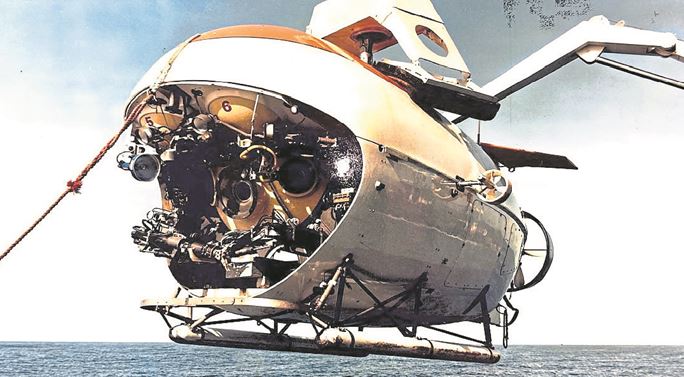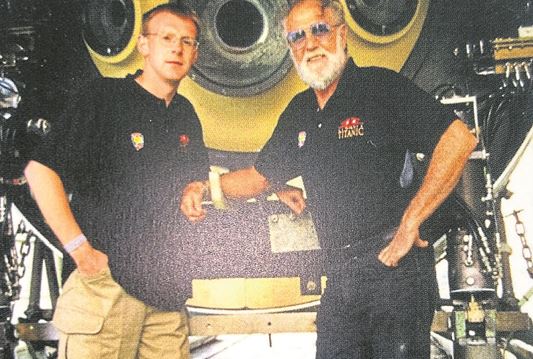By Diarmaid Doherty

The MIR submersible being launched from the ship
A Donegal man, thought to be the first ever Irish person to visit the wreck of the Titanic, said the experience is one that he will cherish for the rest of his days.
It’s almost 24 years since Paul Boyle from Ardara won a competition on a Dublin radio station where the prize was a dive in the MIR submersible to visit the wreck off Newfoundland.
Memories of that once in a lifetime expedition were reawakened with a jolt recently when five men died after their submersible suffered a catastrophic implosion while attempting to view the wreck of the Titanic.
Paul’s expedition in September 1999 was carried out in a different type of submersible from a Russian scientific vessel.
He said that reading and watching reports of last month’s incident, it’s clear the Titan submersible was not fit for purpose.
A search and rescue operation began on June 18 after Titan lost communication with its mother ship, the Polar Prince.
In the days that followed, hopes began to quickly fade that those on board would be recovered alive.
Last week, it was reported that debris from the craft was brought ashore and human remains were also recovered from the water.
“Before it was reported that the vessel had imploded, they were concerned that those on board would have been running out of oxygen,” Paul said.
“You could only imagine what it would have been like for them down there, knowing that they would run out of oxygen and that they were running out of time.
“But if the submersible imploded – which is what they now think happened – they would have died instantly.”
Looking back on his own experience in 1999, Paul said the chance to visit the wreckage came shortly after the film Titanic was released.
“The film sparked so much interest in the story of the Titanic and when I won the radio competition, it was brilliant.
“Last week I was watching the reports coming through from St John’s in Newfoundland. That’s where our expedition set off from on a Sunday morning back in September 1999.
“We were on a Russian vessel that had two submersibles and they were actually designed to explore underwater volcanoes and other geological sites.
“There were 16 people including myself who would take part. You had two per submersible plus the pilot over the course of six days of diving.
“I remember they were a mix of the great and the good. Two other people from Scotland also won competitions but the others had to pay out almost $50,000 to take part.”
On their way to the site of the wreck, those taking part in the dive were trained and well prepared for what lay ahead.
The passengers got to spend time in the submersibles with the hatch closed to get used to the small space and issues of claustrophobia in such a confined space.
After two days of setting out, Paul’s crew reached the site on Tuesday morning, September 14, 1999. His dive was scheduled for two days later, on Thursday.
The dive would last almost 12 hours and the two submersibles went down together. On the front of the sub were a series of robotic arms and lighting booms used to light up the site of the Titanic wreckage.
The robotic arms would later be used when Paul’s submersible accidentally struck some of the Titanic’s wreckage.
“It was a hairy 20 minutes or so,” Paul said.
“It’s only now when you look back, you realise that it was pretty serious and I remember looking at our pilot and seeing the concerned look on his face.”
Paul remembers the launches taking place at 9am each morning with everyone gathering on the upper decks to watch the cranes lower the subs into the water.
On one of the mornings, the subs had to be towed further than normal to allow for a pod of passing whales.
Ahead of his dive, Paul and his fellow crew had to follow a strict diet and there was very little sleep. Feeling a mix of nerves and excitement, Paul and his fellow crew entered their sub and soon after, once the hatch was closed, the 2.5 hour descent began.
All these years later, Paul’s description of what followed is quite vivid.
“By the time we got to 300m, the natural light had disappeared so the sub’s lights were switched on and almost in an instant, the ocean came to life. It was just breathtaking.
“As we continued to descend, we were able to see all these different creatures and sites, but by 1,200m most of the sea life had disappeared.”
At 11.28am, the submersive arrived on the ocean floor and Paul said one of the first items they saw was the forward cargo door of the Titanic. It had not been previously discovered.
They would spend the next few hours surveying the wreckage, and being left in awe at the sight of the ship’s bow.
“It’s only then that you realise the immense size of the ship,” Paul said.
They got to see deep into the bowels of the ship and spread out on the ocean floor, over an area of around half a mile, they saw all sorts of items – cups, plates, suitcases – lying untouched.
The crew enjoyed lunch after their pilot set the sub down on the deck of the Titanic.
Their expedition, which lasted almost five hours, ended with them traversing the hull of the ship to Captain Smith’s cabin – it’s a tradition that all dives end with a visit to this cabin.
Soon after, the subs began their ascent.
Three and a half hours later, they reached the surface and when they arrived back to their ship, the guests and other crew members greeted them with champagne to toast their safe return.
Writing in Dearcadh, the Ardara magazine, in 2013 to celebrate the 100th anniversary of the sinking of the Titanic, Paul said: “It was an absolute privilege to be one of the first Irishmen to see the most famous ship in the world up close.
“The entire experience was exhilarating, but never far from your thoughts was the knowledge that this was a scene of great tragedy; an enormous loss of life for people seeking a better life in the new world.
“There was also the irony that, with the exception of a few lucky individuals, Titanic is still reserved for the rich and powerful, who can afford to visit her.
“Those days in September 1999 will stay with me forever”.
Now married to Aisling, Paul has three children Eilis (17), Niall (14) and Ellen (12).
“Times were very different back then,” he said.
“Now I’ve got my wife and our three children and all the responsibilities that go with that so my days of exploring the wreck of the Titanic are behind me.”










